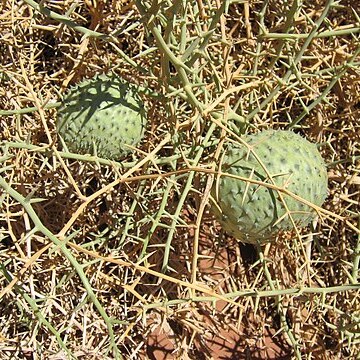Monoecious, deep-rooted, pungent, much-branched shrub, up to 1 m tall, with leafless often longitudinally grooved stems bearing paired spines at nodes, without tendrils. Male flowers solitary or clustered, 10-12 mm long, pale yellow. Female flowers solitary in spine axils, 10-12 mm long, pale yellow with green venation, with greyish hairs outside. Fruit ± spherical, ± 200 mm diam., pale orange-yellow when ripe, with spine/bristle-tipped fleshy conical protuberances, edible when ripe. Seeds highly nutritious. Flowering sporadically throughout year, mainly Feb.-Oct.
A pumpkin family plant. It is a creeper or bush 1.3-1.6 m high. It has opposite thorns. It has a long woody taproot. The stem has grooves along it. It also has spines in pairs 2-3 cm long. The leaves are like small scales. The flowers are of single sexes and in the axils of the spines. The fruit has a rough skin. It has prickles. It is about 20 cm across. A single shrub can cover a large area.

